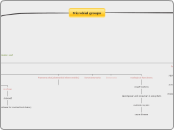Microbial groups
Eucaryotes
fungus:primary terrestrial,few freshwater and marine
slime/water molds:resemble fungi in appearance and style
algae:simple aquatic plants,lack of vascular conducting system and simple reproductive system
protozoa:motile eucaryotic unicellular protist
nutrition
holozoic nutrition
saprozoic nutrition
Reproduction
asexual:binary fission
sexual:conjugation
ecological role
in marine food chain
interaction with higher organism
distribution
planktonic
benthic
neustonic
Nutrition:photoautotrophic or chemoheterotrophic
Reproduction:sexual or asexual reproduction
ecology
seaweed
phytoplankton(food base for marine food chains)
Myxomycota(plasmodial slime molds)
Acrasiomycota
Oomycota
ecological functions:
engulf bacteria
decomposer and consumer in ecosystem
nutrient recycler
cause disease
feeding forms:
saprobic heterotrophs
parasitic heterorophs
mutualistic heterotrophs
ecological impact
decomposers
pathogens
reproduction
sexual,asexual or both
procaryotes
bacteria:various morphology
reproduction
binary fission
Subtopic
nutrition
photoautotrophs
chemotrophs
autotrophs
heterotrophs
ecolgical function
recycling of chemical components
symbiotic relationships
environmental applications
Viruses
obligate intracellular parasites
cannot replicate outside the cells
replication steps:
a)attachment/absorbtion
b)penetration
c)replication
d)assembly
e)release
ecological functions
causes disease in human
biological warfare
